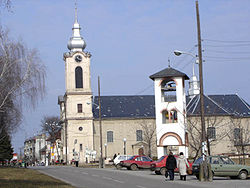| Revision as of 12:36, 10 June 2015 editFDrago77 (talk | contribs)249 edits added Category:Hungarian-speaking territorial units in Serbia using HotCat← Previous edit | Revision as of 11:49, 15 June 2015 edit undoSerial Number 54129 (talk | contribs)Autopatrolled, Extended confirmed users, Page movers, New page reviewers, Pending changes reviewers, Rollbackers99,479 editsm Reverted 1 edit by FDrago77 (talk) to last revision by Thehoboclown. (TW)Next edit → | ||
| Line 117: | Line 117: | ||
| ] | ] | ||
| ] | ] | ||
| ] | |||
Revision as of 11:49, 15 June 2015
Village in Vojvodina, Serbia| Bajmok БајмокBajmok | |
|---|---|
| Village | |
 Street in Bajmok, the Catholic Church, and bell-tower of the Orthodox church Street in Bajmok, the Catholic Church, and bell-tower of the Orthodox church | |
| Country | |
| Province | |
| Time zone | UTC+1 (CET) |
| • Summer (DST) | UTC+2 (CEST) |
 Subotica
Kelebija
Palić
Mala Bosna
Ljutovo
Hajdukovo
Bački Vinogradi
Šupljak
Bikovo
Donji Tavankut
Gornji Tavankut
Mišićevo
Bajmok
Đurđin
Stari Žednik
Novi Žednik
Višnjevac
Čantavir
Bačko Dušanovo
Municipality of
Subotica
Kelebija
Palić
Mala Bosna
Ljutovo
Hajdukovo
Bački Vinogradi
Šupljak
Bikovo
Donji Tavankut
Gornji Tavankut
Mišićevo
Bajmok
Đurđin
Stari Žednik
Novi Žednik
Višnjevac
Čantavir
Bačko Dušanovo
Municipality ofSubotica
●
Bajmok (Serbian Cyrillic: Бајмок; Template:Lang-hu, Hungarian pronunciation: [ˈbɒjmok]) is a village located in the Subotica municipality, in the North Bačka District of Serbia. It is situated in the autonomous province of Vojvodina. The village is ethnically mixed and its population was 8,586 at the 2002 census.
Name
In Serbian Cyrillic the village is known as Бајмок, in Serbian Latin as Bajmok, in Hungarian as Bajmok, in Bunjevac as Bajmok or Bajmak, in Croatian as Bajmak (since 2009) or Bajmok (before 2009), and in German as Nagelsdorf.
History
The first written documents relating to Bajmok came from the fifteenth century. Then the village was for the first time officially mentioned as a village. King Matthias gave it to his mother, Erzebet Szilágyi. The deed of donation was confirmed on 16 February 1462.
During Ottoman administration (16th-17th century), two villages with this name were mentioned: Bajmok and Novi Bajmok. Both villages had about 20 houses. Population was composed of ethnic Serbs. These villages existed until the beginning of the 18th century when they were abandoned.
The village was rebuilt between 1770 and 1785. In this time, settlers were mainly Bunjevci and Hungarians. At the time of the Hungarian revolution, in the fields of this village there was a conflict between the Hungarian and the Vojvodinian Serb army, won by the Hungarians. In 1910, population of the village was mainly composed of Hungarians, Bunjevci and Germans, with some Serbs living there as well.
After World War I, new Serb settlers came to the village. During the Second World War, this village was under the Hungarian occupation. Many of the citizens were exiled from their homes (including the Hungarian population) in order to make room for Csango newcomers. Bajmok was liberated from the Hungarian fascists on 19 October 1944. After World War II, 2,090 (mostly Serb) colonists settled in Bajmok, which enlarged village population to 11,789. Until 1991, the largest ethnic group in the village were Hungarians, while 2002 census recorded that Serbs are most numerous ethnic group in Bajmok.
Ethnic groups (2002 census)
The population of the village included:
- 2,900 (33.78%) Serbs
- 2,450 (28.54%) Hungarians
- 1,266 (14.75%) Bunjevci
- 700 (8.15%) Croats
- 454 (5.29%) Yugoslavs
- 102 (1.19%) Montenegrins
- 653 (8.3%) others
Historical population
- 1961: 11,714
- 1971: 10,861
- 1981: 9,586
- 1991: 8,620
See also
References
- http://webrzs.stat.gov.rs/axd/en/popis.htm
- Antal Mojzeš, Radnički pokret u Bajmoku, Subotica : NIO Subotičke novine, 1984; page 5
- Antal Mojzeš, Radnički pokret u Bajmoku, Subotica : NIO Subotičke novine, 1984; page 6
- "Kaponjska bitka" in Bajmok, Szabadka: Grafoprodukt; 2002. page 270
- Antal Mojzeš, Radnički pokret u Bajmoku, Subotica : NIO Subotičke novine, 1984; page 84
- Slobodan Ćurčić, Broj stanovnika Vojvodine, Novi Sad, 1996.
External links
- www.bajmok.co.rs Template:Sr icon
- www.subotica.com/tag/bajmok Template:Sr icon
- www.subotica.rs/sr/1051/mz-bajmok Template:Sr icon
| Cities, towns and villages in the North Bačka District | ||
|---|---|---|
| Subotica |  | |
| Bačka Topola | ||
| Mali Iđoš | ||
| (*) bold are municipalities or cities | ||
45°58′N 19°25′E / 45.967°N 19.417°E / 45.967; 19.417
Categories: